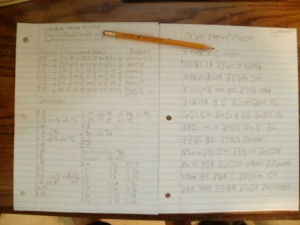English Abjad Cipher: Difference between revisions
From FrathWiki
Jump to navigationJump to search
No edit summary |
mNo edit summary |
||
| Line 15: | Line 15: | ||
|style="border-bottom: 1pt solid #c0c0c0; width: 30%"| Time period: ||style="border-left: 1pt solid #c0c0c0; border-bottom: 1pt solid #c0c0c0; width: 70%"| Presently used in Artwork | |style="border-bottom: 1pt solid #c0c0c0; width: 30%"| Time period: ||style="border-left: 1pt solid #c0c0c0; border-bottom: 1pt solid #c0c0c0; width: 70%"| Presently used in Artwork | ||
|- | |- | ||
|style="border-bottom: 1pt solid #c0c0c0; width: 30%"| Parent systems: ||style="border-left: 1pt solid #c0c0c0; border-bottom: 1pt solid #c0c0c0; width: 70%"| Arabic, Bramhi, Dbu Can (7th Century Tibetan), Hebrew, Hiragana (Japanese), Khmer, Phoenician, Malayalam, Oriya, Sarada, Sanskrit, Syriac, & Thai | |style="border-bottom: 1pt solid #c0c0c0; width: 30%"| Parent systems: ||style="border-left: 1pt solid #c0c0c0; border-bottom: 1pt solid #c0c0c0; width: 70%"| Arabic, Bramhi, Dbu Can (7th Century Tibetan), Old Hebrew, Hiragana (Japanese), Khmer, Phoenician, Malayalam, Oriya, Sarada, Sanskrit, Syriac, & Thai | ||
|} | |} | ||
The '''English Abjad Cipher''' is a constructed script made for the purpose of writing beautifully and with an exotic air. Its current use is in artwork and on calligraphy scrolls. Although it was created to write in English, it has enough characters to write in most Romance languages, Japanese, Korean, Cebuano, Tagalog, and most Germanic languages (Germanic languages with changing the meaning of the unused character to β). | |||
== Spelling Conventions == | |||
Latest revision as of 17:24, 4 October 2011
| English Abjad Cipher | |
|---|---|
| Type: | Abjadic Substitution Cipher |
| Spoken languages: | English |
| Creator: | Motonjia |
| Time period: | Presently used in Artwork |
| Parent systems: | Arabic, Bramhi, Dbu Can (7th Century Tibetan), Old Hebrew, Hiragana (Japanese), Khmer, Phoenician, Malayalam, Oriya, Sarada, Sanskrit, Syriac, & Thai |
The English Abjad Cipher is a constructed script made for the purpose of writing beautifully and with an exotic air. Its current use is in artwork and on calligraphy scrolls. Although it was created to write in English, it has enough characters to write in most Romance languages, Japanese, Korean, Cebuano, Tagalog, and most Germanic languages (Germanic languages with changing the meaning of the unused character to β).
